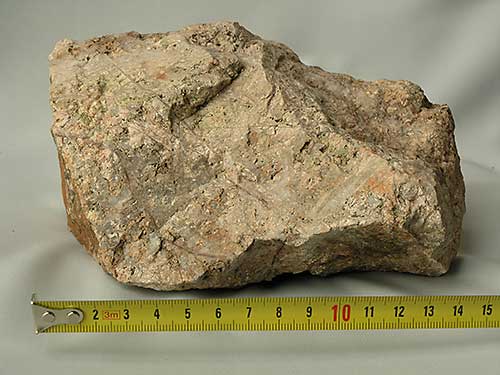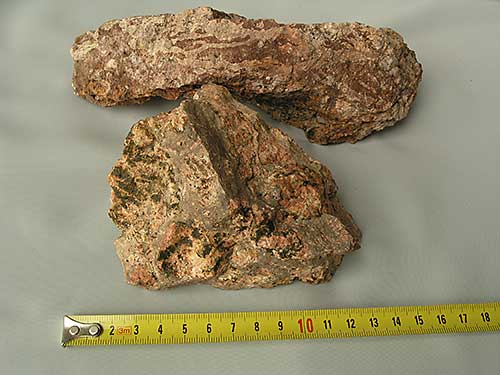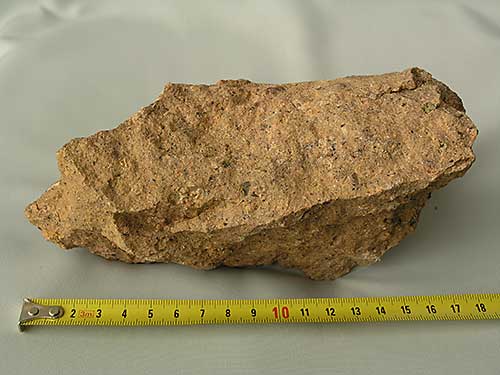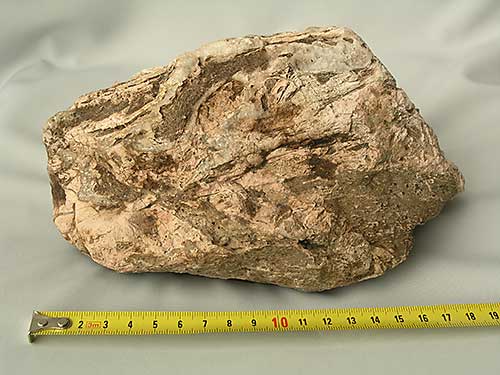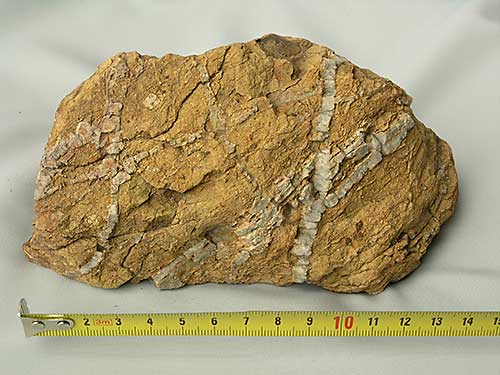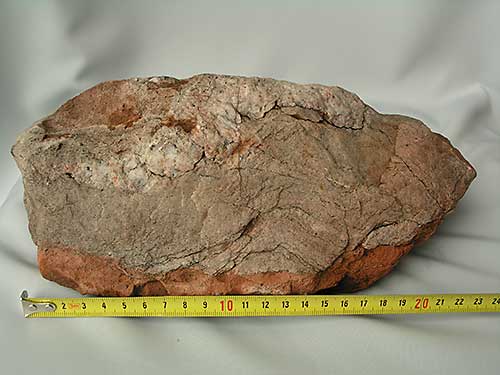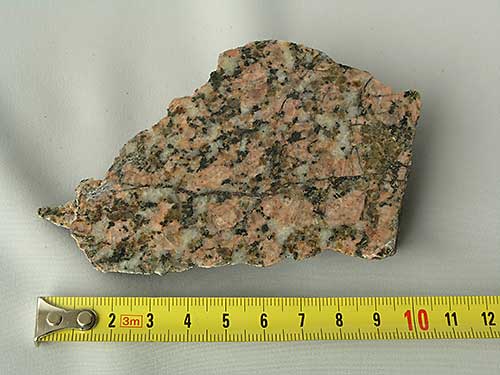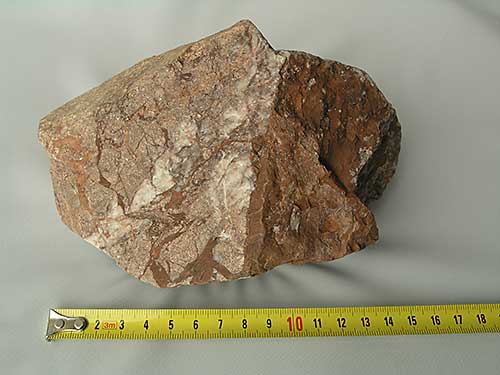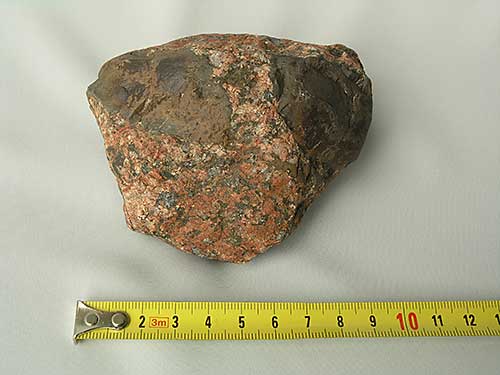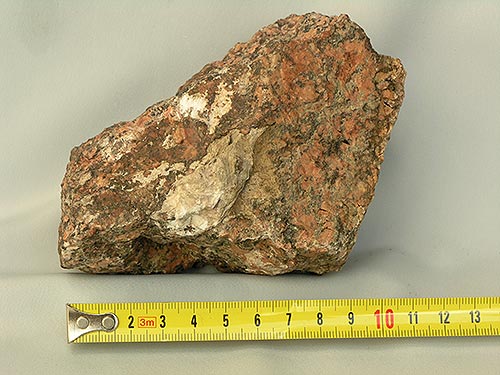SEVERAL RECENTLY DISCOVERED SUPPOSED ASTROBLEMES IN DALECARLIA, SWEDEN
Version 4.4

Download printable complete version in pdf-format (24 MB)
Part 2
7. DESCRIPTION OF THE INDIVIDUAL ASTROBLEMES
7.1 THE LAKE SILJAN ASTROBLEME
To obtain tokens for the recognition of all the other minor astroblemes we first must discuss the finds from the Siljan-astrobleme. If these are accepted as consequences of a meteorite impact, similar rocks and features at other places have to be accepted as a proof of an astrobleme for that site, too. Here we have to be aware of the fact, that blocks of Siljan-material may have been transported by Holocene ice to the present site.
During exploration for Natural Gas twenty years ago in the centre of the Siljan ring an outcrop has been discovered (Pos. A), consisting of the solidified impact-melt. Unfortunately this author does not know, who has made this discovery and if it is published. For this reason it is here unsuitable to mention the coordinates of that outcrop.
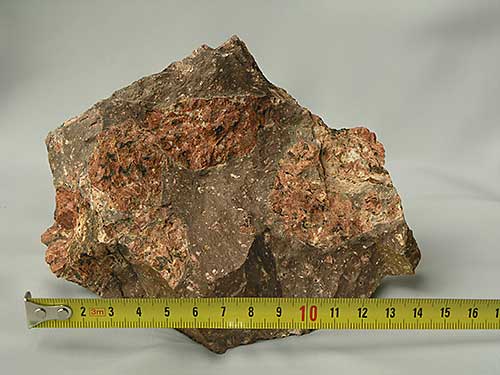 |
| Fig. 1: Impact-melt breccia from (Pos. A). |
In its most homogeneous part this rock resembles a dark-brown Dalecarlia-porphyry, which should have been overlooked, when found as a loose boulder in the till. Of course this outcrop should not be touched. However, there exist plenty of boulders of nearby origin in the local till. Some can be regarded as suevites 6.12, others as impact-melt breccias 6.11. In these latter, thermally and mechanically damaged granite is floating within the brown melt (sometimes glass is used for melt). Here we have a large difference to porphyry: Phenocrysts in porphyries are monomineralic; here the melt contains fragments of the target rock, consisting of several minerals (Fig. 1). This is the final proof that the Siljan ring is an astrobleme.
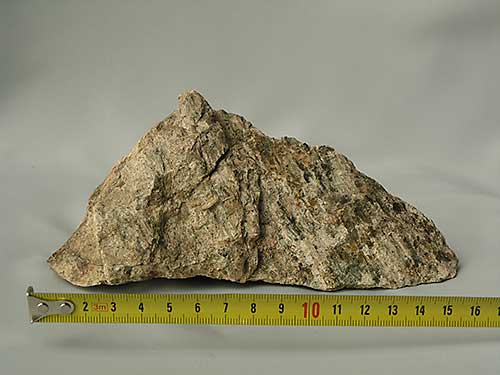 |
| Fig. 2: Gliding in sheared granite (Pos. B). |
At (Pos. B), a gravel pit on the road to the lake edge at Garsås, one can collect all types of impact-created rocks: Melt, completely crushed and reconstructed granite (Fig. 2), pseudotachylites in granite (Fig. 3) and an impact rock, metamorphosed by steam (Fig. 4a).
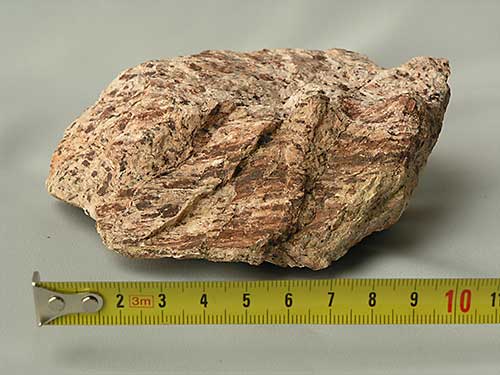 |
| Fig. 3: Peudotachylites in sheared granite (Pos. B). |
During the 1960:s the only evidence for the astrobleme hypothesis was the ring trench, shattered and tilted sheets of carbonate rock from Ordovician and shatter cones in the centre of the structure. Since then it has been shown, that shatter cones are not at all so rare, but can be found here and there, e.g. in the till at the edge of the Lake Siljan near the village Stumsnäs, there at a stone pier (Pos. D). Some 100 m NE of that point there is an outcrop on the shoreline (visible only at low water level), consisting of crushed granite in carbonate-silicate slurry.
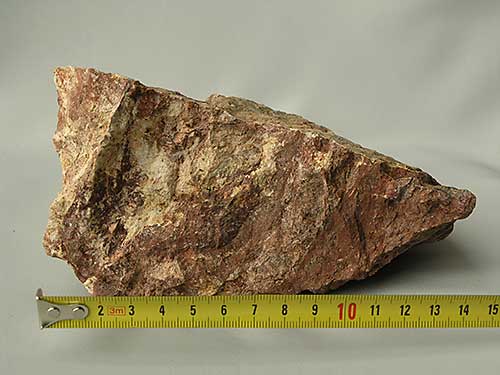 |
| Fig. 4a: Weathered melt, probably exposed to steam (Pos. B). |
In addition, there is a new site of crushed and quartz-annealed granite at the Lake Siljan shore, belonging to the village Garsås, (Pos. C). Annealing of meteorite-damage by quartz differs from that of structural movement, since in the first case the boulders are criss-crossed by the quartz-veins, whence in the other case there is only one (1) direction of quartz annealing. At (Pos. C) there are so many boulders that the outcrop has to be close; best it is seen at low-level water. At this site one can find:
- completely smashed granite
- a reconstructed rock, consisting of quartz
- quartz formed in situ with asphaltenes in cracks
- shatter cones
In reference /4/ Liljequist gives a further compilation of structures/textures, created by the impact of a larger meteorite.
Near (Pos. C) is a pier at (Pos. Aq), built up by boulders, dragged from the nearby waters. Here boulders up to 500 kg of pure white quartz are seen, showing an unusual rectangular cleavage. Since in the local bedrock pegmatites are not known, the origin of the quartz boulders and their cleavage is not known.
Another, easily accessible site is the shore of Lake Siljan at the church of Rättvik, (Pos. Ar). There a cross is raised on an outcrop of a preserved so called Silurian sandstone. In fact, the outcrop has been formed during the impact of the meteorite during Lower Devon. Details of this interpretation will be given in chapter 9: An attempt to understand the origin of the Orsa sandstone. The shore below the cemetery (accessible at low-water, only) contains a lot of other impact-damaged rocks, too. Mainly they consist of fine-grained calcite like marble, of white, reddish or greenish colour. However, they are not primary sediment (layered Ordovician limestone), but consist of sintered carbonate dust, without traces of fossils or other bedding texture. This is clearly seen by the presence of quartz grains in the weathered carbonate surface. The visible grains are lifted above the surface of the limestone by corrosion of the latter, have often the shape of a lens. New quartz-grains (from a deeper level) can easily be disclosed by etching. Certainly this mixture of quartz and calcite is due to the blasting of the pulverized bedrock during the seconds of impact. Primary calcareous sediment at sea bottom is always free from visible quartz- and other grains. A similar bolder of reconstructed calcite is exposed outside the public library at Rättvik. In this paper the term ‘reconstructed rock’ is used for similar formations. See Fig. 4b.
 |
| Fig. 4b: Reconstructed calcite from (Pos. Ar). Real lengths of view is 3,5 cm. |
Here this author would like to add additional information on particular sites according to:
Ring-shaped trenches, waterfilled and/or dry (6.1):
- Lake Flosjö
Tilted plates (6.3):
- In the Siljan astrobleme: Carbonate quarries at Amtjärn, Skålberg and Osmundsberg
- In the Leksands astrobleme: Granite at Käringberget and several similar sheets north of Käringberget
- In the Almo astrobleme: The island Storön in the Almo lake
Note: Tilted plates not necessarily occur at the rim of the crater, only. For example, there is a limestone quarry at (Pos. An), with the former horizontal carbonate beds now upraised to vertical position. This site is only 12 km distant from the centre of the Lake Siljan-astrobleme.
There is no report from the Siljan astrobleme of large fields of local giant boulders (6.5) in the moraine; however, these are found in the Stora Flaten-, the Flosjön-, the Hummelsjön- and the Rågsvedenastrobleme.7.2 THE LAKE STORA FLATEN-ASTROBLEME
During the spring 2005 this author has found evidence for, that the ring north of the village Dala-Järna, including the lakes Stora Flaten and Stora Snesen, could be an astrobleme. This ring has a diameter of 10,5 km, measured between the outer rims of the ring dike. Its centre is at (Pos. E). To reach interesting sites take the forest road between the lakes Stora Snesen and Åskaken, which starts from the public road between Leksand and Dala-Järna at (Pos. F) and reaches after 3 km the south end of the minor lake Långtjärn. East of the road you are within a large area, where one or two years ago the forest has been cut down and the undergrowth burned away. The fire has removed all brush and cleaned the boulders. Here again it is easy to find similar samples as in the Lake Siljan-astrobleme like:
- Shattered granite, cured by criss-cross of later quartz veins (Fig. 5)
- Impact-melt breccias, within which fragments of granite float in the melt (Fig. 6)
- Boulders, resembling pyroclasts (Fig. 7)
- Shatter cones in moraine boulders
At (Pos. G), near a dead birch, there lie two boulders. One of them is very similar to the impact-melt breccias from the Siljan region (Fig. 6). The elongated sample is from the Stora Flaten-astrobleme, the rounder from the Siljan region at (Pos. A). The other boulder from the dead birch (Fig. 8a) has another character, not found in the Siljan-region. It resembles a pyroclast like one from the Azores or from south of Rome. It consists of small granite fragments in a yellow ash and probably is a suevite. Please leave these boulders untouched as examples for other visitors. There is no problem to find similar samples on the burned spot.
Fig. 8a shows a block found in a small gravel pit north of the northern end of Lake Långtjärn (Pos. H). The melt in this block is darker then that from the Siljan region. The white and grey inclusions in this sample are calcite (Note: This is not a late filling of cracks by a solution, but mechanically agglomerated calcite grains). In other samples, not shown here, there is more calcite. How can calcite enter a “granite”, if not mechanically?
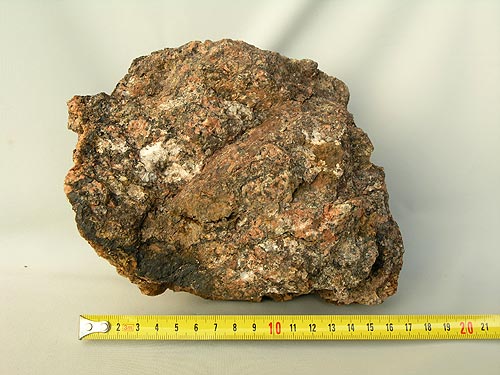 |
| Fig. 8a: The sample contains a darker melt than that from Lake Siljan and some agglomerated calcite (Pos. H). |
Another site for finds of impactites is a recently built forest road, which starts at (Pos. I) and leads to the west. At the end of that road (Pos. J) you can find impact-melt breccias. One can speculate, why impactites have not been found within the ring yet, but outside the ring at Långtjärn. There are some low hills, may be of 30 m height above lake level, to day completely covered by till. We may assume, that these hills contain a core of impactite-material, from which the small boulders are derived.
Some readers may suggest, that the samples found at the Lake Långtjärn may have come there by icedrift from the Siljan-ring. This cannot be the case: The ice flow direction from the centre of the Siljan astrobleme passes Långtjärn about 40km east. Besides, the impactites are very fragile and could never stand such a long journey.
Lake Stora Flaten forms the northern branch of this supposed astrobleme and Lake Stora Snesen its eastern part. Inside this ring, but also outside, there are extended fields of large local moraine boulders. These are very little worked by transport. Most of the boulders are several m3 large; the largest one at is about 50 m3 large. We believe, that the bedrock has been broken up during the impact; the fractures certainly have been annealed by quartz. 377 million years later, under the Holocene ice cover, the old fractures have broken up again and the boulders form these large fields, see (Pos. K).
Another site for finds from this astrobleme is an old gravel pit at the northern end of Lake St.Baggbod-Öradstjärn at (Pos. L). This place is south of the Lake Stora Flaten astrobleme; most probably the impact specimen have come there transported by ice. A further site is a gravel pit at (Pos. As). There reconstructed granite, sealed by a dark melt, is to be found.
At the northern shore of Lake Stor-Flaten a very interesting observation has been made. The lake has quite clean water, somewhat dyed by humus, but low in nutritive salts. Also its level varies due to damming. This prevents the establishment of algae on stones at the water’s edge. Between (Pos. Av) and (Pos. Aw) on the shore almost every stone/bolder has been affected by the impact. However, most interesting is a rather rich occurrence of layered flint. Real flint is in Dalecarlia a very rare mineral (chalcedony), is much rarer than e.g. the rare alkaline volcanic rock tinguaite. Where from comes layered flint? The answer must be: From Ordovician or later up to Devonian limestones. These contain radiolaria, the quartz of which concentrates by metamorphosis in bands within the limestone beds. This certainly happened in the whole sedimentation basin, but has been preserved, only, under the ashes of an astrobleme. The flint is white, greenish or peach.
 |
Fig. 8b: Boulder consisisting of flintpieces, wrapped in red-brown melt. Part of the inclusions is flint. |
At (Pos. Aw) a bolder has been found – see Fig. 8b – that is a breccia of flint, only, glued together by a red-brown melt. Several similar boulders have been found at other astroblemes and confused this writer: One near (Pos. G), one at (Pos. V) and one near (Pos. Ax). The sample from (Pos. Aw) shows very clearly, that a hot melt has been pressed into a loose heap of shattered flint.
The objects shown in Fig.8b, Fig. 17 and Fig. 18 could be formed like Melosh /12/ indicates in his figure 8.2.a). However, to be honest, an other mode should be mentioned, too. Lundquist and Svedlund /12/ have studied breccia and other rocks in northern Dalarna. These rocks have been formed in the interface between the Dala porphyries and the covering Dala sandstones. Look particularly for their figure 65. The key question is, what the brown matrix consists of: Vitrified glass or sintered sand?
Considering the relative positions of the lakes Mellan-Flaten, Siksjön, Skålsjön and Stora Snesen these lakes form a quadrant of a circle with its centre at Flatnäsberget (142570E/672525N). This could be the centre of the impact, if this in fact was vertical; the named lakes could be the outer rim of a complex crater. From this centre 2.6 km (as the crow flies) to NE there is a large gravel pit at position (142793E/622686N), opened to supply material for a new forest road.
Here we find very many samples of local rock, which have been heavily affected by the impact: Almost all consist of reconstructed rock. A tentative explanation could be: During the impact the rock within the central regions of the astrobleme has been pulverized and blown up, together with the vaporized residues of the meteorite. At the time of the impact this rock has been Silurian slate, Ordovician carbonate and Precambrian base rock. This mixture fell back, its components started to react with one another during the following millions of years. Crystals of quarts and feldspar grew in the mixture, could displace the soft calcite and attained free forms at their surface. In recent times, when the rock has been broken up by land ice, the blocks have been exposed to weathering and the carbonate has been dissolved out of these stones.
To day their surface is extremely rough, showing the welldevelloped faces of the ingoing crystals and a very visible porosity after exsolved carbonate. The following figures cannot really show how large this porosity in fact is. A drop of water immediately disappears into the sample. See Fig. 8c and 8d.
 |
| Fig. 8c: Highly porous sample of reconstructed granite. |
 |
| Fig. 8d: Highly porous sample of reconstructed granite. |
Fig. 8e shows another interesting thing: Due to the fact that this sample is practically free from visible quarts the sample should to day be called a reconstructed syenite. It consists of mainly microcline, some plagioclase and plenty of black chlorite. Chlorite contains a lot of iron, which is not normal constituent of granites, except as hornblende. However, an iron meteorite could very well supply the needed iron atoms. Note in the lower part of the figure a dyed quarts dike; this is a later event in the history of this stone.
 |
| Fig. 8e: Consolidated “fall-out” from particle-cloude. |
A third interesting sample originates from position (142871E/672568N), here shown as Fig. 8f. Here the ingoing mineral grains have no other generic relation to one another than that they are an air-borne sediment from the cloud of blown-up fragments.
 |
| Fig. 8f: Reconstructed syenite with dark chlorite. |
7.3 THE LAKE FLOSJÖN ASTROBLEME
Studying the map sheet 13E SO Vansbro more carefully one would discover, that lake Flosjön is part of a ring trench with a perimeter of about 220˚, with its centre at position at (Pos. M) and a radius of 5 km. In the east this ring passes the Harpick-island in the Lake Flosjön and the hill Tutberget on that island (Pos. R). Tutberget is nothing else than a tilted sheet, similar to Käringberget in the town of Leksand. It rises about 27 m above the level of the lake, with strike 20˚E and a dip of 60 to 80˚E. Another indication for an astrobleme is the accumulation of large local moraine boulders in the centre of the ring at a location named Trolldalen and at other locations near the ring.
With the previous knowledge from the Stora Flaten-astrobleme this author has investigated a nearby location outside of the ring, i.e. the foot of the hill Bodberget near the Alpine pasture Forsbodarna (Pos. N). According to rumors hepatica should grow there. Indeed, it was found there in a granite region on a saddle surface between Bodberget and Forsbodarna. In the amelioration cairns - besides normal granite - boulders were found, very similar to impact-melt breccias. These contained isolated clusters of free calcium carbonate (no late filling of cracks), which explains the occurrence of hepatica and other carbonate-preferring plants (Fig. 9).
Recently a new forest road has been built from the nearby road terminating at Forsbodarna; this new road starts about 400 m north of the end of the Forsbodarna road and leads to the saddle. Along this new road and at the saddle surface several further amelioration cairns have been detected, which contains hundreds of boulders that are damaged by an impact. Of one of these boulders a thin slide for microscopic examination was prepared. Even there crushed grains of individual minerals are seen; other minerals fill the crevices.
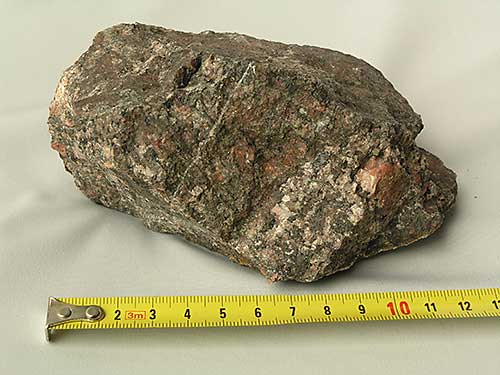 |
| Fig. 9: Plenty of dark glass in this sample. The white dots are calcite and a calcium-silicate (Pos. N). |
Along a recently built forest road N of the summit of Bodberget in the valley of the brook Nordanbergsängs-bäcken (Pos. O), there are further boulders with cracks, filled with pseudotachylite. However, the richest site for finds is quite near at (Pos. P), which is an area ploughed some years ago, where the trees have been cut down. It is about 100 m W of the turning for Forsbodarna. There almost every block or boulder is affected by an impact; mostly you will find secondary impactites of type 2.3 of our classification. Fine-grained material seems to have been collected at a particular site and later sledded downhill, forming a rock, similar to subaquatic turbidities, see Fig. 10, 11 and 12.
Likewise there is a dark red metamorphic rock, consisting mainly of red microcline and small amounts of epidote, almost free from quartz, Fig. 13. Despite this rock is similar to red porphyry, it is free from a glass phase. Similar red microcline is formed in fracture zones from the stone powder. Here and there on the sites there are boulders of the similar Garberg granite or Garberg porphyry from a site about 75 km NNW, and for this reason the red metamorphic rock could be a fraction from Garberg. However, this red metamorphic rock is found at all sites of impactites, only, which makes the Garberg origin somewhat questionable. One can imagine that a hot-water fluid had leached powdered granite. The fluid has removed all quartz and left behind the potash-feldspar powder, which later on metamorphosed to the red rock.
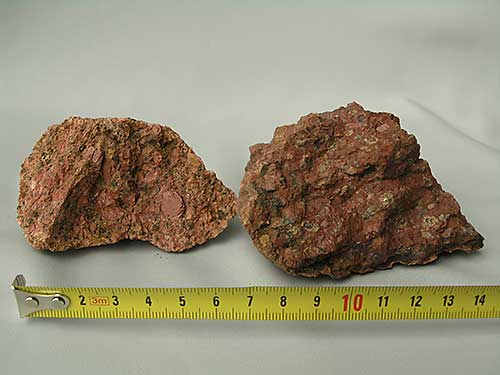 |
| Fig. 13: Very dark red microcline like that formed from mylonite in a slip cracks. The dark dots are rounded grains of quartz. |
Recently (in 2010) a new area nearby has been ploughed and thus has disclosed plenty of impactgenerated samples. It is at the previously mentioned turning for Forsbodarna, but south of this turning. There every second stone or boulder is affected by the impact. Fig. 13a shows a quarts-free sintered ash or sediment with an overcrossing wide quartsvein. Fig. 13b shows the red brown feldspar-residue. This ploughed field is an unlimited supply of impact-generated samples.
 |
Fig. 13a: Recrystallised ’ashes’ from Lake Flosjön-astrobleme |
 |
Fig. 13b: Microcline-rich ’ashes’ from Lake Flosjön-astrobleme |
A further location for finds is the centre of the Lake Flosjö-astrobleme at Trolldalen. There, in addition to giant scale boulders, at (Pos. Q) an old gravel pit with heaps of discarded stones and boulders occurs. This material – as everywhere in gravel pits - is water-transported to the very site, therefore not typical for the bedrock just below. There exist stones of the local granite, which evidently have been crushed to debris, but cured by glass to a new resilient stone, se Fig. 14 and 15. The glass content varies between 10 to 90%. The rock is hard, not equally disintegrated as the impacted granite from the Lake Siljan astrobleme. At this site a stone was found containing two balls of glass, of the size of a hen’s egg, see Fig. 16a. Before the impact, there are no cavities in the granite, which could be filled with the liquid glass. Thus the granite during the impact must have been disintegrated to grains, around which the glass has been pressed in; subsequently this mass has solidified to the resilient rock, we find to day.
At the same site (Pos. Q) another stone has been found, which – after deliberate crushing – showed grains of granite floating in a dark-brown melt, see Fig. 16b. There are white grains in the mixture, too, which proved to be calcite. How can calcite enter reconstructed “granite”, if not mechanically after the original granite has been shattered to small fragments? This site is near the centre of the impact: Its force there has acted vertically downwards and had only a small component of sheer aside, which is found in more peripheral locations. This could be the explanation for the resilient glass-impregnated granite.
Recently (August 2010) at (Pos. Q) several large blocks of shattered granite, cured by a melt, containing large inclusions of that melt have been found, see Fig. 16c. These samples are comparable with the bests from the Siljan-astrobleme.
 |
Fig. 16c: Sample of reconstructed granite with solid melt |
Another site ofrich occurrences is a slope at (Pos. V). There and even at (Pos. G) two very strange blocks have been found; without doubt these are conglomerates. In the Siljan-area there exist conglomerates at at least two locations: At Lake Djurssön and at the village Söderås, 2 km S of Rättvik. These conglomerates are ordinary conglomerates, containing rounded stones of different nature in sandy sediment as matrix.
The conglomerate from (Pos. V and G) is completely different from ordinary conglomerates: The round inclusions consist of an amorphous material like flint, but contain round cavities like gas-bubbles. These are partly filled with crystals. One gets the impression of a solidified, devitrified glass with gas inclusions, Fig. 17 and 18. Fig. 18 is the rear side of the right sample in Fig. 17. The matrix of the conglomerate is the brown stuff like in Fig. 4a. Could this be some late agglomeration of original impactite material? Ordinary conglomerates do not contain balls of amorphous material with gas bubbles! However, these samples could equally well originate from the bottom-breccia in northern Dalecarlia, described by Lundqvist and Svedlund /12/.
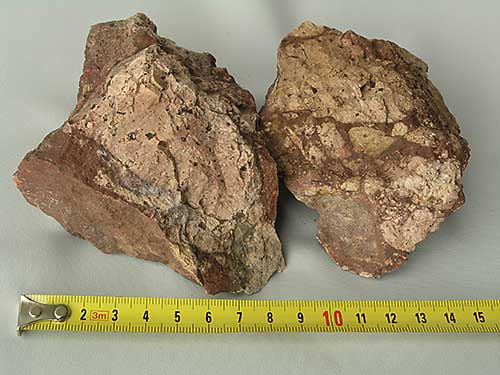 |
| Fig. 17: Conglomerate consisting of balls of flint-like stuff in a matrix similar to impact-melt. |
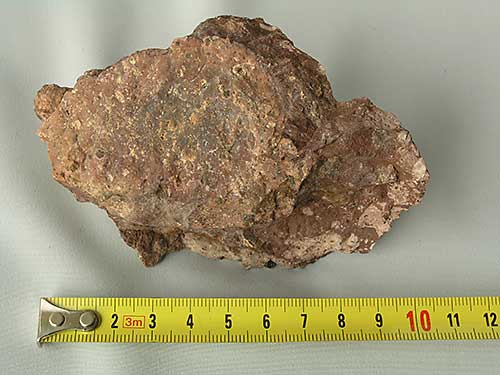 |
| Fig. 18: Rear side of right-hand sample in Fig. 17 showing the flint-like stuff. |
Two kilometers south of (Pos. V) there is another one (Pos. W) within a small, protected area – Björberget - that is extremely rich in hepatica. This site is so far away from the Lake Siljan astrobleme that in this granite a local source of carbonate must exist, either a residue of the original cover of carbonate or boulders of carbonate, transported there. Transport from the Siljan-astrobleme is extremely improbable. A thick cover of soil makes the excavation difficult. Pseudotachylites are found, too, in very fine-grained granite along a forest road at (Pos. Ao).
All these sites and occurrences, also the tilted granite sheet on the Harpick-island, makes me completely convinced of the astrobleme origin for this ring.
Download printable complete version in pdf-format (24 MB)
© 2014-07-21 Erich Spicar
